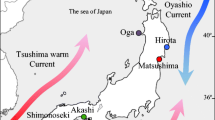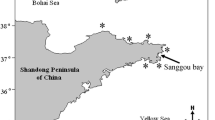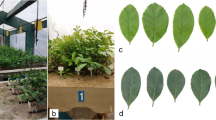Abstract
Undaria pinnatifida is grown for food and industrial materials worldwide; therefore, advanced breeding is needed to meet quality and productivity requirements. In this study, we examined regional lines of U. pinnatifida from five cultivation sites in Japan with different environmental conditions: Oga (OGA, the northern Sea of Japan coast), Hirota Bay (HRT, the northeastern Pacific coast), Matsushima Bay (MAT, the northeastern Pacific coast), Naruto (the Seto Inland Sea coast) and Shimonoseki (SIM, the southern Sea of Japan coast). The sporophytes of these lines were cultured in a tank culture system under controlled environmental conditions, and their morphological characteristics, nutrient uptake kinetics (V max, K s and V max/K s ), and carbon, nitrogen and phosphorus contents were determined. Sporophytes from MAT grew faster, whereas those from SIM were smaller than those from the other sites. Although the blade thickness of sporophytes cultivated in the sea significantly differs among cultivation sites in the previous study, there was no significant difference in blade thickness among the regional lines cultivated in the tank. Sporophytes from OGA had the greatest V max/K s values and significantly greater nitrogen contents than the other lines. Therefore, the morphological characteristics of MAT and SIM sporophytes, and the nutrient uptake kinetics of OGA sporophytes may have a genetic origin. This indicates that these lines may represent useful resources for selective breeding, with MAT sporophytes providing faster growth and OGA sporophytes being well-adapted to low-nutrient conditions.






Similar content being viewed by others
References
Aitken D, Antizar-Ladislao B (2012) Achieving a green solution: limitation and focus points sustainable algal fuels. Energies 5:1613–1647
Bracken MES, Williams SL (2013) Realistic changes in seaweed biodiversity affect multiple ecosystem functions on a rocky shore. Ecology 94:1944–1954
Bracken MES, Jones E, Williams SL (2011) Herbivores, tidal elevation, and species richness simultaneously mediate nitrate uptake by seaweed assemblages. Ecology 92:1083–1093
Buschmann AH, Troell M, Kautsky N (2001) Integrated algal farming: a review. Cah Biol Mar 42:83–90
Dan A, Ohno M, Matsuoka M (2015) Changes of the research and development on the resources of Undaria and Laminaria in the culture ground of Tokushima coasts. Bull Tokushima Pref Fish Res Inst 10:25–48 (Japanese with English abstract)
Dean PR, Hurd CL (2007) Seasonal growth, erosion rates, and nitrogen and photosynthetic ecophysiology of Undaria pinnatifida (Heterokontophyta) in southern New Zealand. J Phycol 43:1138–1148
Gao X, Agatsuma Y, Taniguchi K (2013a) Effect of nitrate fertilization of gametophytes of the kelp Undaria pinnatifida on growth and maturation of the sporophytes cultivated in Matsushima Bay, northern Honshu, Japan. Aquacult Int 21:53–64
Gao X, Endo H, Taniguchi K, Agatsuma Y (2013b) Genetic differentiation of high-temperature tolerance in the kelp Undaria pinnatifida sporophytes from geographically separated populations along the Pacific coast of Japan. J Appl Phycol 25:567–574
Hara M, Akiyama K (1985) Heterosis in growth of Undaria pinnatifida (Harvey) Suringar. Bull Tohoku Reg Fish Res Lab 47:47–50
Harrison PJ, Hurd CL (2001) Nutrient physiology of seaweeds: application of concepts to aquaculture. Cah Biol Mar 42:71–82
Harrison PJ, Parslow JS, Conway HL (1989) Determination of nutrient uptake kinetic parameters: a comparison of method. Mar Ecol Prog Ser 52:301–312
Healey FP (1980) Slope of the Monod equation as an indicator of advantage in nutrient competition. Microbial Ecol 5:281–286
Holdt SL, Edwards MD (2014) Cost-effective IMTA: a comparison of the production efficiencies of mussels and seaweed. J Appl Phycol 26:933–945
Holdt SL, Kraan S (2011) Bioactive compounds in seaweed: functional food applications and legislation. J Appl Phycol 23:543–597
Hurd CL, Dring MJ (1990) Phosphate uptake by intertidal fucoid algae in relation to zonation and season. Mar Biol 107:281–289
Hurd CL, Harrison PJ, Bischof K, Lobban CS (2014) Seaweed ecology and physiology, second edn. Cambridge University Press, Cambridge, p 551
Ishikawa Y (1991) Analysis of quantitative traits in cultured Wakame for breeding. Fish Genet Breed Sci 16:19–24 (in Japanese)
Japan Fisheries Cooperative (2016) Annual report of Wakame in the Sanriku region
Kato S, Sumitomo T, Dan A (2010) Cultivar improvement of Undaria pinnatifida by crossing gametophytes originated from one zoospore. Algal Resour 3:205–210 (in Japanese with English abstract)
Kawai H (1972) Hydrography of the Kuroshio extension. In: Stommel H, Yoshida K (eds) Kuroshio, physical aspects of the Japan current. University of Washington Press, Seattle, pp 235–352
Kuckuck H, Kobabe H, Gerhard W (1985) Fundamentals of plant breeding. Springer, Berlin, p 236
Kusaka K, Sasaki R, Tsukada T (2007) Growth and morphological characteristics of native Wakame (Undaria pinnatifida) seed collected from eight locations around Japan coast. Miyagi Pref Rep Fish Sci 7:17–28 (in Japanese)
Li JY, Murauchi Y, Ichinomiya M, Agatsuma Y, Taniguchi K (2007) Seasonal changes in photosynthesis and nutrient uptake in Laminaria japonica (Laminariaceae: Phaeophyta). Aquac Sci 55:587–597
Li JY, Agatsuma Y, Nagai T, Sato Y, Taniguchi K (2009) Differences in resource storage pattern between Laminaria longissima and Laminaria diabolica (Laminariaceae; Phaeophyta) reflecting their morphological characteristics. J Appl Phycol 21:215–224
MAFF (Ministry of Agriculture, Forestry and Fisheries) (2013) Annual report of Ministry of Agriculture, Forestry and Fisheries 2013 annual report of catch statistics on fishery and aquaculture. Ministry of Agriculture, Forestry and Fisheries, Tokyo
Menzel DW, Corwin N (1965) The measurement of total phosphorus in seawater based on the liberation of organically bound fractions by persulfate oxidation. Limnol Oceanogr 10:280–282
Nanba N, Fujiwara T, Kuwano K, Ishikawa Y, Ogawa H, Kado R (2011) Effect of water flow velocity on growth and morphology of cultured Undaria pinnatifida sporophytes (Laminariales, Phaeophyceae) in Okirai Bay on the Sanriku coast, northeast Japan. J Appl Phycol 23:1023–1030
Nishida Y (1999) Relation between hydrographic conditions and harvest of konbu kelps. In: Taniguchi K (ed) The ecological mechanism of “Isoyake” and marine afforestation. Kouseisha Kouseikaku, Tokyo, pp 50–61 (in Japanese)>
Niwa K (2015) Experimental cultivation of Undaria pinnatifida for double cropping in Pyropia farms around Akashi Strait, Hyogo prefecture. Jpn J Phycol 63:90–97 (in Japanese with English abstract)
Niwa K, Harada K (2016) Experiment on forcing cultivation of Undaria pinnatifida sporophytes in the Seto Inland Sea by using free-living gametophytes cultured in laboratory. Jpn J Phycol 64:10–18 (in Japanese with English abstract)
Pang SJ, Hu XY, Wu CY, Hirosawa A, Ohno M (1997) Intraspecific crossing of Undaria pinnatifida (Harv.) Sur. – a possible time-saving way of strain selection. Chin J Oceanol Limnol 15:227–235
Peteiro C, Freire O (2011) Effect of water motion on the cultivation of the commercial seaweed Undaria pinnatifida in a coastal bay of Galicia, Northwest Spain. Aquaculture 314:269–276
Saigusa M, Kumano Y, Tsukada T (2009) Growth and morphological characteristics of the six generations of Wakame Undaria pinnatifida from Tsushima cultivated in Kesennuma Bay. Miyagi Pref Rep Fish Sci 9:25–32 (in Japanese)
Saito Y (1972) On the effect of environmental factors on morphological characteristics of Undaria pinnatifida and the breeding of hybrids in the genus Undaria. In: Abbott IA, Kurogi M (eds) Contributions to the systematics of benthic marine algae of the North Pacific. Japanese Society of Phycology, Kobe, pp 117–132
Sakanishi Y, Iizumi H (1998) Photosynthesis–temperature relationship of Laminaria longissima Miyabe (Laminariales, Phaeophyta). Jpn J Phycol 46:105–110 (in Japanese with English abstract)
Sato J (2015) Wakame Nyumon. The Japan Food Journal, Tokyo, p 164 (in Japanese)
Sato Y, Hirano T, Niwa K, Suzuki T, Fukunishi N, Abe T, Kawano S (2016) Phenotypic differentiation in the morphology and nutrient uptake kinetics among Undaria pinnatifida cultivated at six sites in Japan. J Appl Phycol 28:3447–3458
Sato Y, Yamaguchi M, Hirano T, Fukunishi N, Abe T, Kawano S (2017) Effect of water velocity on Undaria pinnatifida and Saccharina japonica growth in a novel tank system designed for macroalgae cultivation. J Appl Phycol 29:1429–1436
Shan TF, Pang SJ, Li J, Gao SQ (2016) Breeding of an elite cultivar Haibao no.1 of Undaria pinnatifida (Phaeophyceae) through gametophyte clone crossing and consecutive selection. J Appl Phycol 28:2419–2426
Skriptsova A, Khomenko V, Isakov V (2004) Seasonal changes in growth rate, morphology and alginate content in Undaria pinnatifida at the northern limit in the sea of Japan (Russia). J Appl Phycol 16:17–21
Takemoto A, Oda M (1997) New Planktic Foraminiferal transfer functions for the Kuroshio : Oyashio current region off Japan. Paleontol Res 1:291–310
Tanada N, Dan A, Kato S, Oka N, Hamano T (2015) Cultivar improvement of Undaria pinnatifida (Harvey) Suringar by reciprocal crossing free-living male/female gametophytes between a Kagoshima natural strain and a Naruto cultivar. Algal Resour 8:103–112 (in Japanese with English abstract)
Tatewaki M (1966) Formation of a crustose sporophyte with unilocular sporangia in Scytosiphon lomentaria. Phycologia 6:62–66
Torres AI, Gil MN, Esteves JL (2004) Nutrient uptake rates by the alien alga Undaria pinnatifida (Phaeophyta) (Nuevo gulf, Patagonia, Argentina) when exposed to dilute sewage effluent. Hydrobiologia 520:1–6
Troell M, Halling C, Neori A, Chopin T, Buschmann AH, Kautsky N, Yarish C (2003) Integrated mariculture: asking the right questions. Aquaculture 226:69–90
Wheeler PA, Björnsater BR (1992) Seasonal fluctuations in tissue nitrogen, phosphorus, and N:P for five macroalgal species common to the Pacific northwest coast. J Phycol 28:1–6
Yamanaka R, Akiyama K (1993) Cultivation and utilization of Undaria pinnatifida (wakame) as food. J Appl Phycol 5:249–253
Yoshimori A, Kono T, Iizumi H (1998) Mathematical models of population dynamics of the kelp Laminaria religiosa, with emphasis on temperature dependence. Fish Oceanogr 7:136–146
Acknowledgements
We sincerely thank Haruo Hosoya (Riken Vitamine Co., Ltd.), and Hironobu Watanabe, Katsunori Ono and Junichi Sato (Riken Food Co., Ltd.) for their guidance throughout this research. We are very grateful to Osamu Sakuma, Tatsuya Musashi and Takahiro Saido (Iwate Prefectural Fisheries Technology Centre), Masaki Yamaguchi (Coastal Regional Development Bureau, Department of Fisheries in Iwate Prefecture), Susumu Ohwada and Osamu Hatakeyama (Hirota Bay Fisheries Cooperative), Hiroshi Akama (Seafoods Akama Co., Ltd.), Akihito Tojyo (Tojyo Shouten), Kenji Yoshitake (Yamaguchi Prefecture Fisheries Cooperative), Nobuyuki Hosoda (Haedomari Fisheries Cooperative), Kazuyoshi Saito and Dr. Nobuyasu Nakabayashi (Akita Fisheries Centre), and Wataru Suzuki (Wataru Suisan) for providing the sporophytes of cultivated Undaria pinnatifida and cultivated Undaria, and for their generous support during the field surveys. We also thank Dr. Nobuyasu Nanba and Misaki Shinozuka (Kitasato University) and Dr. Kinuko Ito (Tohoku University) for their valuable advice and cooperation in the measurement of nutrients concentration, and carbon and nitrogen contents. We thank Yutaka Ito, Miho Mogamiya and Naoko Sasaki (Riken Food Co., Ltd.) for their technical support in measuring the morphological characteristics and cultivation in the CFCS. This study was partly supported by the Formation of Tohoku Marine Science Centre Project (Technical Development That Leads to the Creation of New Industries) from the Ministry of Education, Culture, Sports, Science, and Technology of Japan.
Author information
Authors and Affiliations
Corresponding author
Electronic supplementary material
......
Supplemental Fig. 1
Typical Undaria pinnatifida individuals cultivated at each site for 140–150 days according to the methods described in Sato et al. (2016). HRT: Hirota Bay, MAT: Matsushima Bay, NAR: Naruto, OGA: Oga, SIM: Shimonoseki (PPTX 141 kb)
Supplemental Table 1
(XLSX 37 kb)
Supplemental Table 2
(XLSX 38 kb)
Supplemental Table 3
(XLSX 34 kb)
Supplemental Table 4
(XLSX 35 kb)
Supplemental Table 5
(XLSX 36 kb)
Rights and permissions
About this article
Cite this article
Sato, Y., Hirano, T., Ichida, H. et al. Morphological and physiological differences among cultivation lines of Undaria pinnatifida in a common garden experiment using a tank culture system. J Appl Phycol 29, 2287–2295 (2017). https://doi.org/10.1007/s10811-017-1170-y
Received:
Revised:
Accepted:
Published:
Issue Date:
DOI: https://doi.org/10.1007/s10811-017-1170-y




